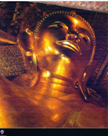Take a peek into the allures of Bangkok through the eyes and words of our member, Mr Sujoy Kumar Roy, who visited the temple town, also one of Asia’s most important transit hubs, last year.
Bangkok is a top joint. Girlie shops, pub dames, masseurs, they don worn-out fractional shorts. Entwined love-smitten teenagers take nomadic detours in the marts and lanes. At outdoor services, the food salivates, the lobsters stare you down, while the lambs end up as chops. It is a sin to flinch from buying such culinary trash. Am I a Socrates on an austerity high, or hungry wolf? One wonders.
Bangkok is a temple city. There are statuesque manifestations of Buddha, emerald, golden, laughing, sky-tall, all shining swanky bright against background of thronging sight-seers looking like human chain in the blink of history. The local language is quite a tongue-twister. Seventy-two muscles that we use while speaking rebel in the midst of pronouncing the word riddles. Here goes Bangkok’s ceremonial name: “Krung Thep Mahanakhon Aman Rattanakosin Mahinthara Yothaya Mahadilok Phop Noppahrat Ratchathani Burirom Udomratchaniwet Mahasthan Amon Awa tan Sahit Sakkathattiya Witsanukam Prasit”. When translated the name goes like “The city of angels, the great city, the eternal jewel, impregnable city of God Indra, grand capital of the world endowed nine precious gems, the happy city abounding in an enormous Royal palace that resembles heavenly abode, a city given by Indra built by Vishnukam”. (Have a glass of water).
The local language is in between Pali and Sanskrit. Baht stands for currency in vogue. One such Thai baht is equivalent to Rs 2.20. I asked the return flight time to Kolkata at my hotel desk to a girl in exquisite silk, she had a painted face with a dumb-doll expression. She quipped 50 bahts before serving up the answer. At every end of the street stands a hotel. All sorts of humanity scramble around the reception desk. A pint-sized man strives to catch an eye, a well-kenned gentleman stands amidst, a man with a mermaid tattoo and eye-brow like a Scottie dog battles against the bump of a Russian traveller.
Thais drive on the left. That is about all. The right of the way on road is determined by the size of the vehicle. The motorcycles slither along. Drive against the flow of traffic is Roman, sometimes drivers manage to transform a single lane for a U-turn to multiple lanes according to traffic density. Frank Sinatra said: “If you can make it here you can make it anywhere.”
But over the decades, the most absolute degrees of spinning traffic are in Hyderabad Charminar Chowk, old Delhi, Kolkata, where the traffic screams and avalanches like angry bees scaring away traffic constabulary. The Bangkok traffic does not honk though, neither spars for blows.
Flick through traffic advisory, you will find that Safari Park is a big draw for children. A floating market sells fruit baskets and small handicrafts on the canals by boats. Its waters sloshed with grease and burnt diesel give a kind of Venetian backwater experience.
Bangkok is Asia’s important transit hub. The Suvarnabhumi airport and Thai’s several airways have provided a jump-start to the economy, which is laced with wealth and low-brow life of immigrant population from Thailand’s many districts. The local population is mostly ethnic Thais, Chinese, Indians and Australians. An overly commercialised megalopolis, it sees muggers, cut-purses. The local taxi or tuk-tuk is a negotiable mode of transport. Women tourists go compulsively shopping. They come back with an appetite to bargain, as if little has been done, but lots not yet had. Men consume alcohol. They stand unswerving like the Statue of Liberty, though a little slanted like the Leaning Tower of Pisa, being light on purse.
Bangkok’s tiger temple is a tame affair. We never knew full grown tigers stretch like lizard on ground, upturned as turtles and not even capable of flaying the flies. Volunteers fan air at them. A tiger is nonce if lies down in such defeatist fashion, which gives way to doubt if the animals are drugged. But they know they do not have to run for prey and food is served to them.
Next is a visit at the site of the bridge built on river Kwai built by Japanese army in 1942-43 by punishing and pushing with lashes raining on war prisoners in a sweltering heat on jungles. The Japs wanted to extend the bridge beyond into Burma in order that the second world war could brought close to the frontier gates of British India empire. The original structure of the bridge was blown away in explosion.
A relic of the extant piece rails is preserved in a museum of a sordid period of history. The Bridge on the River Kwai was a film made in 1957. Remember the whistling tune of the march of British prisoners? The film used portion of the Colonel Bogey March is a British march composed in 1914 by Lieutenant F. J. Ricketts (1881–1945). Pattaya’s sweeping coastlines, water sports, international dining experience and raucous and steamy night life is a huge draw. The Alcazar cabaret show is classy.



